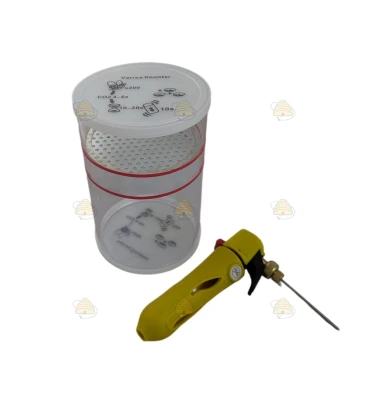Varroa Tester
€ 49,95
Varroa tester for easily calculating the number of varroa mites in a bee colony. How does the varroa tester work and how do I calculate the number of mites in the bee colony? Shake approximately 200 bees into the tester. This is about 25 grams or half a teacup. Then you anesthetize the bees and mites with CO2 (this cartridge is not included) and gently shake the cup. This causes the mites to detach from the bees. These will fall through the separator plate with small holes into the other compartment of the varroa tester. Now the mites can be easily counted. The fastest way to calculate the infestation level in the colony is to divide the number of mites by the number of bees. So 10 mites from 200 bees 10/200= 0.05 equals 5% varroa mite infestation in the colony. Treatment is recommended from 5%. This calculation can also be used for the powdered sugar method. Scroll further down for a step-by-step plan and the calculation to determine the total number of varroa mites in the colony.
Note: don't forget to order a CO2 cartridge (prod. 8169).
The quality of this varroa tester is equal to the original model. However, the CO2 injector is made of plastic instead of metal.
Customer ratings and reviews
Step-by-step guide for varroa tester
- Collect half a teacup of bees from a colony (25 grams) which is up to the red line on the varroa tester
- Spray CO2 into the cup for 4 to 6 seconds and wait 10 seconds
- Gently shake the bees
- Count the mites and divide this number by 200. This shows the percentage. Example: 10 mites / 200 bees = 0.05 = 5% varroa infestation. If you have an infestation < 5%, you don't need to treat the colony. If the infestation is greater than > 5%, it is advised to treat the bee colony against varroa.
You can also calculate how many absolute mites are in the colony. Do this by multiplying the estimated number of bees (A) by the number of mites (B) and dividing by the number of collected bees (200)(C). Example: number of mites in colony = (AxB)/C. These represent approximately 20% of the bees in the colony. Then multiply this number by 5 to determine the total number of mites in the colony.






